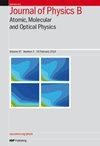简单液体混合物中的电子散射和传输
IF 1.5
4区 物理与天体物理
Q3 OPTICS
Journal of Physics B: Atomic, Molecular and Optical Physics
Pub Date : 2024-01-24
DOI:10.1088/1361-6455/ad1d35
引用次数: 0
摘要
科恩和莱克纳(1967 Phys. Rev. 158 305)提出的简单液体中的电子传输理论被扩展到简单液体混合物。重点是利用珀尔库斯-耶维克模型(Lebowitz 1964 Phys. Rev. A 133 895,Hiroike 1969 J. Phys. Soc. Japan27 1415)来表示密度结构效应,为硬球二元混合物建立基准模型。利用波尔兹曼方程的多期解法研究了二元混合物结构对硬球电子散射截面和传输特性的影响,包括漂移速度、平均能量、纵向和横向扩散系数。针对电子在一系列减弱的电场强度(0.1-100 Td)作用下脱离平衡状态的情况,建立了基准计算。本文章由计算机程序翻译,如有差异,请以英文原文为准。
Electron scattering and transport in simple liquid mixtures
The theory for electron transport in simple liquids developed by Cohen and Lekner (1967 Phys. Rev.
158 305), is extended to simple liquid mixtures. The focus is on developing benchmark models for binary mixtures of hard-spheres, using the Percus-Yevick model (Lebowitz 1964 Phys. Rev. A 133 895, Hiroike 1969 J. Phys. Soc. Japan
27 1415) to represent the density structure effects. A multi-term solution of Boltzmann’s equation is employed to investigate the effect of the binary mixture structure on hard-sphere electron scattering cross-sections and transport properties, including the drift velocity, mean energy, longitudinal and transverse diffusion coefficients. Benchmark calculations are established for electrons driven out of equilibrium by a range of reduced electric field strengths (
0.1 − 100 Td).
求助全文
通过发布文献求助,成功后即可免费获取论文全文。
去求助
来源期刊
CiteScore
3.60
自引率
6.20%
发文量
182
审稿时长
2.8 months
期刊介绍:
Published twice-monthly (24 issues per year), Journal of Physics B: Atomic, Molecular and Optical Physics covers the study of atoms, ions, molecules and clusters, and their structure and interactions with particles, photons or fields. The journal also publishes articles dealing with those aspects of spectroscopy, quantum optics and non-linear optics, laser physics, astrophysics, plasma physics, chemical physics, optical cooling and trapping and other investigations where the objects of study are the elementary atomic, ionic or molecular properties of processes.

 求助内容:
求助内容: 应助结果提醒方式:
应助结果提醒方式:


